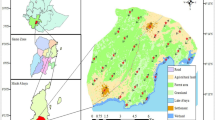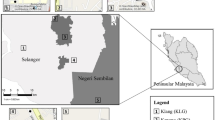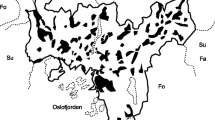Abstract
Although urbanization is generally considered a major threat to local and global biodiversity, some recent studies have shown that urban environments provide suitable habitat for some wildlife species, including carnivores, yet little is known about the factors that determinate their occurrence and habitat preferences. The main aim of this study was to examine the relative importance of habitat characteristics in relation to carnivore occurrence along an urban–rural gradient in the Central Europe. Carnivore occurrence was monitored using scent stations (summer period) and snow tracking (winter period) in the regional city which was divided into the network of 154 quadrates (25 ha/quadrate) for the purposes of this study. From a total of six recorded native carnivore species, the stone marten Martes foina and the least weasel Mustela nivalis were the most dominant and widespread species in both study periods. PCA analysis revealed the existence of two informative axes corresponding to (A) urban vs. non-urban habitat and (B) residential vs. industrial areas. Surprisingly, the only species exhibiting marked habitat selectivity and avoidance of highly urbanized areas was the red fox (i.e. negative correlation with the first PCA axis). The stone marten tends to avoid industrial areas and prefers residential areas; however its presence/absence was not associated with the first PCA axis. On the other hand, the ermine stoat and the least weasel were relatively unselective according to our results. In conclusion, our results demonstrate high adaptability of various species of carnivore mesopredators to urban environment; however their response to the level of urbanization and habitat characteristics exhibits interspecific variation.



Similar content being viewed by others
References
Anděra M, Červený J (2009) Large mammals in the Czech republic. Distribution, history and protection. 2. Carnivores (Carnivora). Národní muzeum, Praha
Angold PG, Sadler JP, Hill MO, Pullin A, Rushton S, Austin K, Small E, Wood B, Wadsworth R, Sanderson R, Thompson K (2006) Biodiversity in urban habitat patches. Sci Total Environ 360:196–204
Baker PJ, Harris S (2007) Urban mammals: what does the future hold? An analysis of the factors affecting patterns of use of residential gardens in Great Britain. Mamm Rev 37:297–315
Baker PJ, Funk SM, Harris S, White PCL (2000) Flexible spatial organization of urban foxes, Vulpes vulpes, before and during an outbreak of sarcoptic mange. Anim Behav 59:127–146
Bateman PW, Fleming PA (2012) Big city life: carnivores in urban environments. J Zool 287:1–23
Bouchner M (2003) Stopy zvěře [Tracks of game]. Ottovo nakladatelství - Cesty, Praha
Brainerd SM, Rolstad J (2002) Habitat selection by Eurasian pine martens Martes martes in managed forests of southern boreal Scandinavia. Wildl Biol 8:289–297
Buskirk SW, Powell RA (1994) Habitat ecology of fishers and American martens. In: Buskirk SW, Harestad AS, Raphael MG et al (eds) Martens, sables, and fishers: biology and conservation. Cornell University Press, Ithaca, pp 283–296
Červinka J, Šálek M, Pavluvčík P, Kreisinger J (2011) The fine-scale utilization of forest edges by mammalian mesopredators related to patch size and conservation issues in Central European farmland. Biodivers and Conserv 20:3459–3475
Červinka J, Šálek M, Padyšáková E, Šmilauer P (2013) The effects of local and landscape-scale habitat characteristics and prey availability on corridor use by carnivores: a comparison of two contrasting farmlands. J Nat Conserv 21:105–113
Crooks KR (2002) Relative sensitivities of mammalian carnivores to habitat fragmentation. Conserv Biol 16:488–502
Crooks KR, Soulé ME (1999) Mesopredator release and avifaunal extinctions in a fragmented system. Nature 400:563–566
Culek M (1995) Biogeografické členění České republiky [Biogeographical classification of the Czech Republic]. Enigma s. r. o, Praha
Davison J, Huck M, Delahay RJ, Roper TJ (2009) Restricted ranging behavior in a high-density population of urban badgers. J Zool 277:45–53
Delibes M (1983) Interspecific competition and the habitat of the stone marten Martes foina (Erxleben, 1777) in Europe. Act Zool Fenn 174:229–231
Dormann CF, McPherson JM, Araújo MB, Bivand R, Bolliger J, Carl G, Davies RG, Hirzel A, Jetz W, Kissling WD, Kühn I, Ohlemüller R, Peres-Neto PR, Reineking B, Schröder B, Schurr FM, Wilson R (2007) Methods to account for spatial autocorrelation in the analysis of species distributional data: a review. Ecography 30:609–628
Faaborg JM, Brittingham M, Donovan T, Blake J (1993) Habitat fragmentation in the temperate zone: A perspective for managers. In: Finch DM, Stangel PW (eds) Status and management of neotropical migratory birds, US forest service general technical report RM-229. Estes Park, Colorado, pp 331–38
Frontier S (1976) Étude de la décroissance des valeurs propres dans une analyse en composantes principales: comparaison avec le modèle du bâton brisé. Biol Ecol 25:67–75
Gehring TM, Swihart RK (2003) Body size, niche breadth, and ecologically scaled responses to habitat fragmentation: mammalian predators in an agricultural landscape. Biol Conserv 109:283–295
Gehrt SD (2010) The urban ecosystem. In: Gehrt SD, Riley SPD, Cypher BL (eds) Urban carnivores - ecology, conflict, and conservation. The John Hopkins University Press, Baltimore, p 285
Gehrt SD, Anchor C, White LA (2009) Home range and landscape use of coyotes in a metropolitan landscape: conflict or coexistence? J Mammal 90:1045–1057
Gloor S, Bontadina F, Hegglin D, Deplazes P, Breitenmoser U (2001) The rise of urban fox populations in Switzerland. Mammal Biol 66:155–164
Gompper ME, Kays RW, Ray JC, Lapoint SD, Bogan DA, Cryan JR (2006) A comparison of noninvasive techniques to survey carnivore communities in northeastern North America. Wildl Soc Bull 34:1142–1151
Harris S, Rayner JMV (1986) Urban fox (Vulpes vulpes) population estimates and habitat requirements in several British cities. J Anim Ecol 55:575–591
Herr J, Schley L, Roper TJ (2009) Socio-spatial organization of urban stone martens. J Zool 277:54–62
Herr J, Schley L, Engel E, Roper TJ (2010) Den preferences and denning behavior in urban stone martens (Martes foina). Mamm Biol 75:138–145
Hilty JA, Merenlender AM (2004) Use of riparian corridors and vineyards by mammalian predators in Northern California. Conserv Biol 18:126–135
Hilty JA, Brook C, Heaton E, Merenlender AM (2006) Forecasting the effect of land-use change on native and non-native mammalian predator distributions. Biodivers Conserv 15:2853–2871
Iossa G, Soulsbury CD, Baker PJ, Harris S (2010) A taxonomic analysis of urban carnivore ecology. In: Gehrt SD, Riley SPD, Cypher BL (eds) Urban carnivores - ecology, conflict, and conservation. The John Hopkins University Press, Baltimore, pp 173–184
Janko C, Schröder W, Linke S, König A (2012) Space use and resting site selection of red foxes (Vulpes vulpes) living near villages and small towns in Southern Germany. Acta Theriol 57:245–250
Johnson DDP, Macdonald DW, Dickman AJ (2000) An analysis and review of models of the sociobiology of the Mustelidae. Mammal Rev 30:171–196
Lenth BE, Knight RL, Brennan ME (2008) The effects of dogs on wildlife communities. Nat Areas J 28:218–227
Lindström ER, Brainerd SM, Helldin JO, Overskaug K (1995) Pine marten–red fox interactions: a case of intraguild predation? Ann Zool Fenn 32:123–130
Long R, MacKay P, Ray J, Zielinski W (2008) Noninvasive survey methods for carnivores. Island Press, Washington
MacArthur RH, Wilson EO (1967) The theory of island biogeography. Princeton University Press, Princeton, New Jersey
Maindonald J, Braun WJ (2007) Data analysis and graphics using R: an example-based approach. Cambridge University Press, Cambridge
McKinney ML (2002) Urbanization, biodiversity, and conservation. Bioscience 52:883–890
Mortelliti A, Boitani L (2007) Evaluation of scent-station surveys to monitor the distribution of three European carnivore species (Martes foina, Meles meles, Vulpes vulpes) in a fragmented landscape. Mammal Biol 73:287–292
Nesvadbová J, Zejda J (1984) The pine marten (Martes martes) in Bohemia and Moravia. Fol Zool 33:57–64
Oksanen J, Blanchet FG, Kindt R, Legendre P, Minchin PR, O’Hara RB, Simpson GL, Solymos P, Stevens HH, Wagner H (2013) vegan: Community Ecology Package. R package version 2.0-7. http://CRAN.R-project.org/package=vegan. Accessed 25 August 2013
Ordeñana MA, Crooks KR, Boydston EE, Fisher RN, Lyren LM, Siudyla S, Haas C, Harris S, Hathaway SA, Turschak GM, Miles AK, Van Vuren DH (2010) Effects of urbanization on carnivore species distribution and richness. J Mammal 91:1322–1331
Piorr A, Ravetz J, Tosics I (2011) Peri-urbanisation in Europe: towards European policies to sustain urban rural futures. A synthesis report. Academic Books, Frederiksberg
Pita R, Mira A, Moreira F, Morgado R, Beja P (2009) Influence of landscape characteristics on carnivore diversity and abundance in Mediterranean farmland. Agric Ecosyst Environ 132:57–65
Randa LA, Yunger JA (2006) Carnivore occurrence along an urban–rural gradient: a landscape-level analysis. J Mammal 87:1154–1164
Riley SPD, Busteed GT, Kats LB, Vandergon TL, Lee LFS, Dagit RG, Kerby JL, Fisher RN, Sauvajot RM (2003) Effects of urbanization and habitat fragmentation on bobcats and coyotes in Southern California. Conserv Biol 17:566–576
Rondinini C, Boitani L (2002) Habitat use by beech martens in a fragmented landscape. Ecography 25:257–264
Šálek M, Síčová P, Sedláček F (2005) Kuna skalní (Martes foina) v městském prostředí: početnost a rozšíření [Stone marten (Martes foina) in urban environment: abundance and distribution]. Lynx 36:111–116
Šálek M, Kreisinger J, Sedláček F, Albrecht T (2009) Corridor vs. hayfield matrix use by mammalian predators in an agricultural landscape. Agric Ecosyst Environ 134:8–13
Šálek M, Kreisinger J, Sedláček F, Albrecht T (2010) Do foraging opportunities determine preferences of mammalian predators for habitat edges in an agricultural landscape? Landsc Urban Plan 98:86–91
Šálek M, Červinka J, Pavluvčík P, Poláková S, Tkadlec E (2014a) Forest-edge utilization by carnivores in relation to local and landscape habitat characteristics in central European farmland. Mammal Biol 79(3):176–182
Šálek M, Červinka J, Padyšáková E, Kreisinger J (2014b) Does spatial co-occurrence of carnivores in a Central European agricultural landscape follow the null model? Eur J Wildl Res 60:99–107
Santos MJ, Santos-Reis M (2010) Stone marten (Martes foina) habitat in Mediterranean ecosystem: effects of scale, sex, and interspecific interactions. Eur J Wildl Res 56:275–286
Soulsbury CD, Baker PJ, Iossa G, Harris S (2010) Red foxes (Vulpes vulpes). In: Gehrt SD, Riley SPD, Cypher BL (eds) Urban carnivores - ecology, conflict, and conservation. The John Hopkins University Press, Baltimore, pp 63–75
Svobodová J, Kreisinger J, Šálek M, Koubová M, Albrecht T (2011) Testing a mechanistic explanation for mammalian predator responses to habitat edges. Eur J Wildl Res 57:467–474
Travaini A, Laffitte R, Delibes M (1996) Determining the relative abundance of European red foxes by scent-station methodology. Wildl Soc Bull 24:500–504
Trewhella WJ, Harris S, McAllister FE (1988) Dispersal distance, home-range size and population density in the red fox (Vulpes vulpes) a quantitative analysis. J Appl Ecol 25:423–434
Venables WN, Ripley BD (2002) Modern applied statistics with S, 4th edn. Springer, New York
Virgós E, Recio MR, Cortés Y (2000) Stone marten (Martes foina) use of different landscape types in the mountains of central Spain. Z Säugetierk 65:375–379
Virgós E, Tellería JL, Santos T (2002) A comparison on the response to forest fragmentation by medium sized Iberian carnivores in central Spain. Biodivers Conserv 11:1063–1079
Vitousek PM, Mooney HA, Lubchenco J, Melillo JM (1997) Human domination of Earth’s ecosystems. Science 277:494–499
Woodroffe R (2000) Predators and people: using human densities to interpret declines of large carnivores. Anim Conserv 3:165–173
Zielinski WJ, Stauffer HB (1996) Monitoring Martes populations in California: survey design and power analysis. Ecol Appl 6:1254–1267
Acknowledgments
This work was supported by the research aim of the Academy of Sciences of the Czech Republic (RVO 68081766), by the grant of Grant Agency of University of South Bohemia 168/2013/P.
Author information
Authors and Affiliations
Corresponding author
Appendixes
Appendixes
Appendix 1
Appendix 2
The principal component analysis based biplot for habitat structure variation across sampling locations. The occurrence of individual species is visualized by colour plotting characters surrounding individual sampling locations (grey symbols). The size of these plotting characters is proportional to a number of records of the given carnivore at the given sampling plot (range = 0–4). The red fox indicated by blue, the marten by red, the ermine stoat by yellow and the least weasel by green colour
Rights and permissions
About this article
Cite this article
Červinka, J., Drahníková, L., Kreisinger, J. et al. Effect of habitat characteristics on mesocarnivore occurrence in urban environment in the Central Europe. Urban Ecosyst 17, 893–909 (2014). https://doi.org/10.1007/s11252-014-0364-1
Published:
Issue Date:
DOI: https://doi.org/10.1007/s11252-014-0364-1






